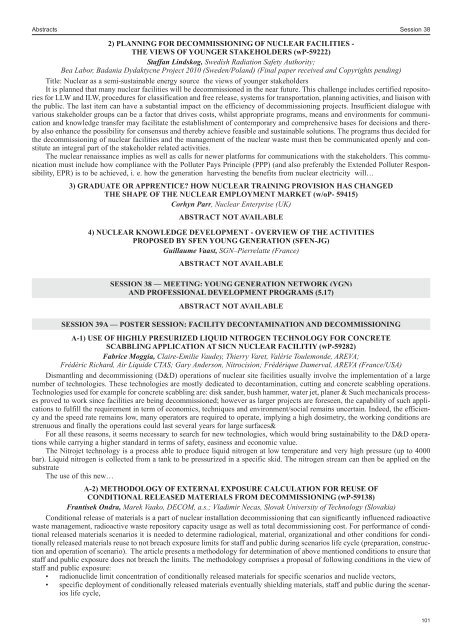ICEM11 Final Program 9.7.11pm_ICEM07 Final Program ... - Events
ICEM11 Final Program 9.7.11pm_ICEM07 Final Program ... - Events
ICEM11 Final Program 9.7.11pm_ICEM07 Final Program ... - Events
Create successful ePaper yourself
Turn your PDF publications into a flip-book with our unique Google optimized e-Paper software.
Abstracts Session 38<br />
2) PLANNING FOR DECOMMISSIONING OF NUCLEAR FACILITIES -<br />
THE VIEWS OF YOUNGER STAKEHOLDERS (wP-59222)<br />
Staffan Lindskog, Swedísh Radiation Safety Authority;<br />
Bea Labor, Badania Dydaktycne Project 2010 (Sweden/Poland) (<strong>Final</strong> paper received and Copyrights pending)<br />
Title: Nuclear as a semi-sustainable energy source the views of younger stakeholders<br />
It is planned that many nuclear facilities will be decommissioned in the near future. This challenge includes certified repositories<br />
for LLW and ILW, procedures for classification and free release, systems for transportation, planning activities, and liaison with<br />
the public. The last item can have a substantial impact on the efficiency of decommissioning projects. Insufficient dialogue with<br />
various stakeholder groups can be a factor that drives costs, whilst appropriate programs, means and environments for communication<br />
and knowledge transfer may facilitate the establishment of contemporary and comprehensive bases for decisions and thereby<br />
also enhance the possibility for consensus and thereby achieve feasible and sustainable solutions. The programs thus decided for<br />
the decommissioning of nuclear facilities and the management of the nuclear waste must then be communicated openly and constitute<br />
an integral part of the stakeholder related activities.<br />
The nuclear renaissance implies as well as calls for newer platforms for communications with the stakeholders. This communication<br />
must include how compliance with the Polluter Pays Principle (PPP) (and also preferably the Extended Polluter Responsibility,<br />
EPR) is to be achieved, i. e. how the generation harvesting the benefits from nuclear electricity will…<br />
3) GRADUATE OR APPRENTICE? HOW NUCLEAR TRAINING PROVISION HAS CHANGED<br />
THE SHAPE OF THE NUCLEAR EMPLOYMENT MARKET (w/oP- 59415)<br />
Corhyn Parr, Nuclear Enterprise (UK)<br />
ABSTRACT NOT AVAILABLE<br />
4) NUCLEAR KNOWLEDGE DEVELOPMENT - OVERVIEW OF THE ACTIVITIES<br />
PROPOSED BY SFEN YOUNG GENERATION (SFEN-JG)<br />
Guillaume Vaast, SGN–Pierrelatte (France)<br />
ABSTRACT NOT AVAILABLE<br />
SESSION 38 — MEETING: YOUNG GENERATION NETWORK (YGN)<br />
AND PROFESSIONAL DEVELOPMENT PROGRAMS (5.17)<br />
ABSTRACT NOT AVAILABLE<br />
SESSION 39A — POSTER SESSION: FACILITY DECONTAMINATION AND DECOMMISSIONING<br />
A-1) USE OF HIGHLY PRESURIZED LIQUID NITROGEN TECHNOLOGY FOR CONCRETE<br />
SCABBLING APPLICATION AT SICN NUCLEAR FACILITIY (wP-59282)<br />
Fabrice Moggia, Claire-Emilie Vaudey, Thierry Varet, Valérie Toulemonde, AREVA;<br />
Frédéric Richard, Air Liquide CTAS; Gary Anderson, Nitrocision; Frédérique Damerval, AREVA (France/USA)<br />
Dismantling and decommissioning (D&D) operations of nuclear site facilities usually involve the implementation of a large<br />
number of technologies. These technologies are mostly dedicated to decontamination, cutting and concrete scabbling operations.<br />
Technologies used for example for concrete scabbling are: disk sander, bush hammer, water jet, planer & Such mechanicals processes<br />
proved to work since facilities are being decommissioned; however as larger projects are foreseen, the capability of such applications<br />
to fulfill the requirement in term of economics, techniques and environment/social remains uncertain. Indeed, the efficiency<br />
and the speed rate remains low, many operators are required to operate, implying a high dosimetry, the working conditions are<br />
strenuous and finally the operations could last several years for large surfaces&<br />
For all these reasons, it seems necessary to search for new technologies, which would bring sustainability to the D&D operations<br />
while carrying a higher standard in terms of safety, easiness and economic value.<br />
The Nitrojet technology is a process able to produce liquid nitrogen at low temperature and very high pressure (up to 4000<br />
bar). Liquid nitrogen is collected from a tank to be pressurized in a specific skid. The nitrogen stream can then be applied on the<br />
substrate<br />
The use of this new…<br />
A-2) METHODOLOGY OF EXTERNAL EXPOSURE CALCULATION FOR REUSE OF<br />
CONDITIONAL RELEASED MATERIALS FROM DECOMMISSIONING (wP-59138)<br />
Frantisek Ondra, Marek Vaako, DECOM, a.s.; Vladimir Necas, Slovak University of Technology (Slovakia)<br />
Conditional release of materials is a part of nuclear installation decommissioning that can significantly influenced radioactive<br />
waste management, radioactive waste repository capacity usage as well as total decommissioning cost. For performance of conditional<br />
released materials scenarios it is needed to determine radiological, material, organizational and other conditions for conditionally<br />
released materials reuse to not breach exposure limits for staff and public during scenarios life cycle (preparation, construction<br />
and operation of scenario). The article presents a methodology for determination of above mentioned conditions to ensure that<br />
staff and public exposure does not breach the limits. The methodology comprises a proposal of following conditions in the view of<br />
staff and public exposure:<br />
• radionuclide limit concentration of conditionally released materials for specific scenarios and nuclide vectors,<br />
• specific deployment of conditionally released materials eventually shielding materials, staff and public during the scenarios<br />
life cycle,<br />
101
















